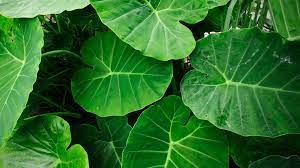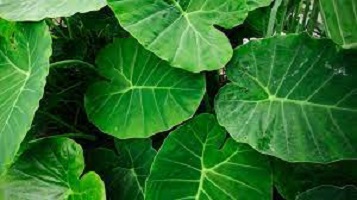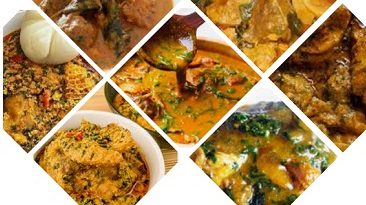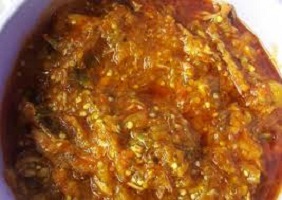Cocoyam Leaves ~ Benefits of Kontomire Leaf & Uses
Cocoyam Leaves ~ Benefits of Kontomire Leaf & Uses. Please Watch >>>>

- Cocoyam leaves, like fluted pumpkin, stimulate blood production – Experts
- The Importance and Health Benefits of Cocoyam Leaves
- Cocoyam leaves Benefits
Table of Contents
Cocoyam Leaves Facts
- Description: Cocoyam, Leaves, raw
- Local Names: Ganyen gwaza (Hausa), Akwukwo ede (Igbo), Ewe koko (Yoruba), Ikopong (Ibibio)
- Scientific Name: Colocasia esculenta
- Category: Vegetables and Products
- Calories in Cocoyam Leaves: The calories in 100 grams of Cocoyam Leaves is 56 calories (kcal).
The Cocoyam Leaves ~ an Overview
The fact that cocoyam leaves (also known as taro or kontomire) are edible often surprises people who have only known this plant as a large root.
Taro (Colocasia esculenta) is a starchy edible tuber with broad greenish leaves. It is grown in a variety of locations around the world.
We usually eat the roots, tubers, or leaves of cocoyam which are known locally as kontomire.
Because they are high in nutrients, both the root and the leaves have numerous health benefits for the body.
It’s a staple food in some African countries like Ghana, Cameroon, and Guinea-Bissau, where it’s used to make delicious vegetable soup and stew.
It’s prepared in the same way that ugu leaves or spinach are used.
The leaves are used to make snacks, chips, and curry sauce in India and China.
Uses of Cocoyam Leaves and Health Benefits
What is Cocoyam?
In the Igbo language, cocoyam or taro (Colocasia esculenta) is known as ede. It’s a starchy, edible tuber with broad, greenish leaves.
It is grown in a variety of locations around the world. It is grown alongside yam and cassava or on its own.
Types
There are various types of cocoyam;
Cocoyam in Nigeria refers to two edible aroid species, Colocasia esculenta (L.) Schott (Taro) and Xanthosoma mafaffa (Tania).
All cocoyams are edible, but they must be thoroughly cooked before consumption. Some cocoyam species are poisonous if consumed.
They are well-known for causing dangerous throat itching when eaten with the normal cocoyam
In that sense, those cocoyam species are used for soup thickening (ede uli), swallowing (utara ede), or overnight boiled cooked cocoyam (ede nghucha).
. For this last option, you need to cook the dangerous cocoyam species overnight. In the morning, the body will turn gray when you peel them.
Uses ~ How to use cocoyam leaf
Cocoyam is grown primarily for its starchy edible roots. Colocasia is cultivated for its corm, which is eaten after boiling, frying, or roasting.
The corms can be dried and ground into flour, or they can be sliced and fried to make chips. The plant’s leaves are also edible and are commonly used as a vegetable in dishes such as stews.
Xanthosoma species produce tubers that are boiled, baked, steamed, or fried before consumption. Some varieties also consume the corm. The young leaves are consumed as a vegetable.
We used to eat this type of cocoyam with ncha sauce when I was a kid. Ncha sauce is made from edible potash (Ngu), ogiri, and red oil (tastes very delicious).
Folks can consume cocoyam roots, tubers, and leaves, which are known locally as kontomire.
Because they are high in nutrients, both the root and the leaves have numerous health benefits for the body
Word of Caution
Please Note: Cocoyam leaves should not be consumed raw! They contain a toxin that irritates when not cooked properly. This is why these leaves should be allowed to soak in cold, clean water for about 10 to 15 minutes before they are cooked!
Then, before using them to prepare your meal, thoroughly cook them to remove the toxic substance of water.
If not properly cooked, it is usually itchy in the throat.
What are the nutritional values of cocoyam leaves?
Cocoyam leaves are extremely high in vitamins A, and C, and various B vitamins like thiamine, riboflavin, and folate.
Manganese, copper, potassium, iron, and calcium levels are also high. It also contains a lot of dietary fiber and has a low-fat content.
To get a better understanding of the cocoyam nutrition benefits, take 1 cup of steamed cocoyam leaves without salt or other spices.
The leaves in the cup will weigh approximately 145g, and the nutritional value will be as follows: Calories – 35 Protein – 4g Carbohydrates – 5.8g Fat – 0,6g (in it, fatty acids Omega 3 – 74mg, Omega 6 – 170mg) Food fibers – 2.9g
What are the benefits of cocoyam leaves for health? Here are some health benefits of Cocoyam leaves.
The well-known “kontomire” is famous for its tasty green soups and stews. But did you know it also has some incredible health benefits?
Let us now look at some of the amazing health benefits.
Immune system booster
Just one cup of these leaves per day can provide you with enough vitamin C to significantly boost your immune system.
Cancer prevention
The same vitamin C is also a potent antioxidant. Because of this feature, it is an excellent defense against free radicals, which cause cancer and a variety of other diseases.
Eye care
The combination of vitamin C and vitamin A found in these leaves is excellent for strengthening your eyes.
Vitamin A is an important component in maintaining your vision and preventing blindness, cataracts, and myopia.
Improvement in digestion
These leaves are high in fiber, which helps to prevent constipation and slow bowel movements.
Lowering cholesterol levels
The less fat you eat and the more vegetables you eat, the lower your blood cholesterol level will be. Again, the high fiber content of the leaves aids in lowering cholesterol levels in the blood
Other Benefits include;
- Weight loss assistance.
- Inflammation reduction.
- Nerve protection.
- Blood pressure normalization.
- Healthy development of a fetus.
- Prevention of anemia.
- Preeclampsia prevention.
- Skin refreshing.
- Muscle improvement.
- Depression control; The ability to release large amounts of dopamine (the hormone, which can improve your mood and give you a sense of satisfaction and pleasure)
Summary of Cocoyam Leaves, Akwukwo ede (Igbo), Ganyen gwaza (Hausa), Ewe koko (Yoruba), Ikopong (Ibibio)
You have already read the preceding paragraph. Cocoyam leaves boost the immune system, prevent cancer, and promote eye health.
It also helps with digestion and prevents digestive problems, lowers cholesterol levels, aids in weight loss, and reduces inflammation.
Cocoyam Leaves Recipe
However, if we do not tell you how to prepare cocoyam leaves for consumption, this post will be incomplete. Cocoyam leaves are high in toxins.
On that note, it should not be consumed raw. If you eat it raw, you may experience severe throat itching.
How to cook cocoyam leaves
To begin, soak them in clean water for about 10-15 minutes.
After that, thoroughly cook them to remove the toxic substance. As I previously stated, it is usually itchy in the throat if not well cooked
Remember, you’re only eating the leaves. Ideally, boil it for 10 minutes, then remove it from the heat and strain the water.
Chop the cocoyam leaves like you would any other vegetable. Cut them to the size you want. Put them back in the pot and add some clean, fresh water. To improve the flavor, add salt and other ingredients.
Boil for another 5 minutes before turning off the heat. Your edible cocoyam leaves are ready. You can make a delicious cocoyam soup and stew with cassava leaves same method
Cocoyam Gardening In Nigeria
In Nigeria, planting dates for cocoyam vary from March/April to April/May. There are two main varieties, white and red varieties.
In the meantime, you could try growing kontomire leaves to get fresh leaves. It is extremely simple.
It can grow at any time and in any place. If necessary, you can use plastic plates or buckets if you don’t have a garden in your place.
Simply get a cocoyam tuber and insert it deeper into the loamy or black soil. Before covering them with soil, make sure the head where the leaves will sprout is facing upward.
People also ask
What is the health benefit of cocoyam leaf?
Cocoyam leaves are high in vitamin A as well as vitamin C.
They are excellent for preserving visual acuity and preventing eye diseases such as cataracts, myopia, and blindness.
Kontomire leaves’ high dietary fiber content aids in food digestion and absorption.
What do you call cocoyam leaves in English?
Explanation and response: Colocasia esculenta is the botanical name for cocoyam leaves. Imperial Taro and Madumbi are two common names for it.
What are the nutritional benefits of cocoyam leaf?
In terms of vitamins and minerals, 1 cup of steamed cocoyam leaves provides your body with the following assortment: 6145 IU Vitamin A (international units) Thiamin (Vitamin B1) – 0.2mg 0.6mg vitamin B2 (riboflavin) 1.8mg vitamin B3 (niacin) 0.1mg vitamin B6 51.5mg vitamin C Calcium
Is cocoyam leaf considered a vegetable?
Cocoyam leaf, an African Indigenous vegetable known as kontomire among the Akans in Ghana, is used to make sauces (‘kontomire’ stew) and soups (‘ebunebunu’).
What are the disadvantages/side effects of eating cocoyam?
Because of the high amount of oxalates in cocoyam, it should be properly cooked before consumption. It should be consumed in moderation because it contains a lot of calories.
Which is healthier cocoyam or yam?
“Cocoyam is more nutritious than other root and tuber crops like cassava and yam, with a higher protein, vitamin, and mineral content.”
Cocoyam is a versatile staple that can also be used as weaning food, and the leaves can be cooked as a vegetable.
Can a diabetic take cocoyam?
Yes, cocoyam is beneficial to diabetics. According to studies, diabetics who were fed cocoyam had a significant reduction in their diabetic level.
Cocoyam also lowers bad cholesterol while raising good cholesterol.
Can you eat cocoyam leaf raw?
Kontomire leaves should not be consumed raw because they contain a dangerous toxin. Please soak them in clean water for about 10-15 minutes first.
After that, thoroughly cook them to remove the toxic substance. If not properly cooked, it is usually itchy in the throat.
Is it healthy to eat cocoyam leaves?
Helps Prevent Kidney Damage
High blood sugar levels can cause kidney damage known as diabetic nephropathy.
According to research, cocoyam may be useful in the treatment of diabetic nephropathy.
Does cocoyam cause high blood pressure?
The high vitamin B6 content of cocoyam is beneficial for controlling high blood pressure and protecting the heart.
Coco yam contains fiber, which aids in gut health, cholesterol reduction, and blood sugar control.
Do cocoyam leaves contain iron?
A diet rich in Kontomire leaves is recommended for the prevention of anemia.
This is due to the presence of iron minerals, which aid in the formation of red blood cells.
Is it safe to eat cocoyam while pregnant?
Kontomire leaves are extremely beneficial to the development of the fetal brain nervous system.
Pregnant women can eat cocoyam leaves to nourish their unborn children.
Folate, which is required for fetal brain and nervous system development, is found in cocoyam leaves.
Cocoyam leaves for pile
Remove the stem and cut the cocoyam into pieces. Get a bunch of it and mix in a bunch of fragrance leaves (Ocimum basilica).
Wrap it in a crisp plantain leaf and tie it with a rope made from the plantain leaf. Allow it to steam for 10-15 minutes after burying it in hot wood cinders.
Taro leaves near me and cocoyam leaves for sale are available in the Nigerian market.
Cocoyam leaf in Yoruba
In Nigeria, the Yorubas call it “Koko,” the Igbos “Ede,” and the Hausas “Gwaza.”



